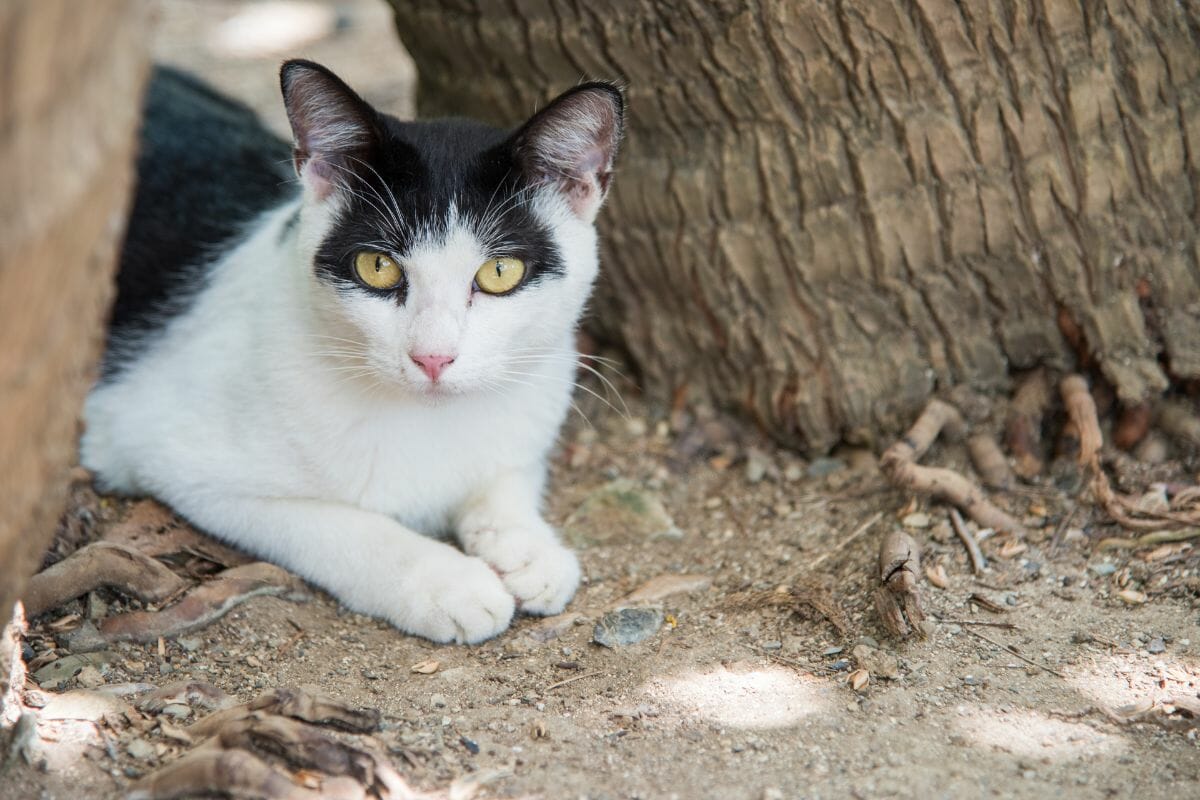Feral cats have caused the most environmental damage in Australia than any other continent in the world.

In Australia, they are estimated to have killed tens of millions of native animals each night.
This ranges from a wide variety of animals including those considered globally threatened.
Moreover, they have been linked to the extinction of at least 20 mammal species and subspecies, such as the desert bandicoot and the lesser bilby(see also: Bandicoots And Bilbies – What’s The Difference?).
Cats first arrived in Australia during the First Fleet in 1788 mainly as companion animals, 70 years later they have covered the continent.
Unfortunately, Australian wildlife, such as night parrots and endangered numbats, has proven particularly susceptible to feral and roaming cats (including house cats that are allowed to roam).
With this in mind, this article will explore everything you need to know about the feral cat epidemic in Australia and how they are causing havoc to biodiversity.
What Are Feral Cats?
Feral cats are known to reproduce, live, and hunt in the wild.
They contain all the necessary characteristics for stalking and capturing prey: an acute sense of smell, fine coordination, and an agile body.
These specific traits have allowed the cats to adapt to some of the harshest conditions in Australia, meaning they can be found across the continent as a result.
In order to survive and reproduce, feral cats require large amounts of fresh meat to survive.
In Australia, these cats typically eat small exotic and native mammals, including insects, birds, and lizards.
Likewise, in Australia, approximately 80 threatened and endangered species are at risk of the feral cat population.
Moreover, they are known to carry diseases that not only affect other animals but can also affect humans.
Initially, cats were introduced as pets to European settlers, later they were deliberately introduced in an attempt to control rodent and rabbit populations.
Now, cats occupy 99% of Australia, this includes many offshore islands.
What Do Feral Cats Eat?
Feral cats are inherently carnivorous, meaning they rely on animal meat to maintain their nutrient levels.
In Australia, feral cats will typically eat small exotic and native mammals – rabbits being the popular choice – but they also eat insects, birds, and lizards.
Although these cats live like prey, they will occasionally scavenge for carrion when fresh meat isn’t available.

How The Other Bilby Was Lost
The baby was known as one of Australia’s national wildlife icons. Although, prior to the 1960s, there were two of these long-eared marsupial species.
The yallara, otherwise known as the ‘lesser bilby’, was a smaller; albeit, feistier version of the greater bilby which is known and loved throughout Australia.
However, unlike its cousin, the yallara couldn’t survive the onslaught of cats that followed after the colonization of Australia.
However, the same thing is happening to the greater bilby: facing a path of extinction due to feral cats and roaming cats.
Once, these animals were found across 70% of the entire continent, now, there are only around 9,000 of these animals left.
In the past 12 years alone, they have faced a 10% decline in their population.
How Many Cats Are In Australia?
Across 99.9% of the Australian continent, there are between 5.9 – 10.1 million cats.
Unlike their prey, cats can increase their population much faster. This means, during times of extreme rainfall, the population of feral cats can quadruple.
- 3.8 million pet cats
- 1.4 – 5.6 million cats are located in the bush, this is dependent on rain conditions
- 0.7 million feral cats found in urban areas
The Dark Side of Cats
All free-roaming cats, both pet and feral, are excellent predators.
In addition to the 27 native species that cats have helped push into extinction prior to colonization, including the Macquarie Island parakeet and the pig-footed bandicoot, they are now jeopardizing another 123 threatened species across Australia.
In fact, this is happening daily, Typically, 1.67 million reptiles, 2.92 million mammals, 0.26 million frogs, 2.97 million invertebrates, and 1.09 million birds every 24 hours.
Without human intervention, cats will continue to drive many species toward extinction.
What’s Being Done?
Ensuring that pet cats remain in the security of their homes, in enclosures, and on a leash guarantees not only their safety but also the safety of wildlife.
Lots of veterinary groups, such as the RSPCA, and animal welfare organizations in Australia have advocated that pet cats are happier and safer in the comforts of their homes.
As of 2022, the ACT Parliament has also taken action against roaming cats whereby broadscale cat containment is now mandatory across the country.
Likewise, the federal government is also taking steps into ensuring a safer environment for wildlife by commencing a parliamentary inquiry concerning the impact that feral and domestic cats have on native wildlife – this received bi-partisan political support.
As a result of this inquiry, there are now six recommendations enforced by the Australian government including:
- Prioritizing and recognizing the issue regarding feral cats in Australia.
- Developing and implementing research concerning the management and implant of feral and pet cats.
- Reconsidering the planning and current policy in response to the rise in feral cats.
- Increasing feral cat-free islands and predator-free fenced areas in Australia.
- Creating a concise strategy to control unowned, partly-owned, and owned pet cats.
- Enhancing organizations such as the National Feral Cast Taskforce, which the Invasive Species Council is a member of, to provide recommendations.
Final Thoughts
While cats can appear cute and cuddly on the outside, they have a much darker side to them that people tend to overlook.
In Australia, the growing number of feral cats is a rising issue with many native species being whipped out entirely due to these predators.
Action needs to be done to prevent any more species from dying. Hopefully, this article has informed you all about feral cats in Australia.









